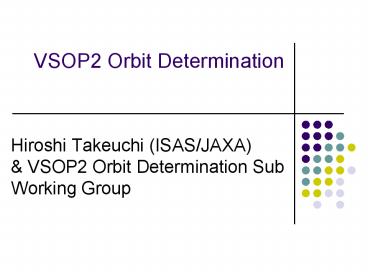VSOP2 Orbit Determination - PowerPoint PPT Presentation
1 / 15
Title:
VSOP2 Orbit Determination
Description:
Pyxis GPS receiver (Broad Reach Engineering) 20cmx12cmx8cm. Dimensions. L1,L2,L5,E1B,E5B ... Pyxis receiver is able to receive Galileo signals. ... – PowerPoint PPT presentation
Number of Views:152
Avg rating:3.0/5.0
Title: VSOP2 Orbit Determination
1
VSOP2 Orbit Determination
- Hiroshi Takeuchi (ISAS/JAXA) VSOP2 Orbit
Determination Sub Working Group
2
Orbital elements of VSOP-2
Precession period of the orbital plane is about
2.2 years. Rotation period of the apogee in the
orbital plane is about 16 months.
3
Orbit determination accuracy (1s) and
Scientific targets (ISAS Doi,Asaki 2007)
- Orbit accuracy(1s) gt30 cm
- On-source observation (Continuum, Galactic
masers) - Orbit accuracy(1s) lt30 cm
- Phase referencing observations in X-band (8.4
GHz) - Orbit accuracy(1s) lt6 cm
- Phase referencing observationsin K-band (22GHz)
- Determination of the Hubble constant by on-source
observations of Megamasers in 22GHz.
4
Orbit determination accuracy (1s) and
Scientific targets (ISAS Doi,Asaki 2007)
- Orbit accuracy(1s) lt3 cm
- Phase referencing observationsin Q-band (43GHz)
- 10 accuracy of distance measurements by
parallax, almost everywhere in our Galaxy
? Target is 3-cm accuracy. (requirement is
10cm.)
5
Orbit determination performance in Halca(VSOP)
- ObservableKu-band Doppler Only
- GPS receiver was equipped, but never used.
- Orbit accuracy10 m 50 m (ISAS solutions)
- 1 m10m (JPL
solutions)
An example of orbit residuals by ISAS in VSOP
(2003 Ohnishi et al.)
VSOP-2 offers 1001000 times better accuracy
compared with VSOP.
6
Specifications of the GPS receiver for VSOP2
- Pyxis GPS receiver (Broad Reach Engineering)
Four independent GPS antennas will be equipped on
the satellite body to cover all directions.
7
Difficulties in the use of GPS for VSOP2
- Complex structures (main reflector, solar panel)
- ? Field-of-view limitation, Multi-path error,
Phase center offsets and variations - Four independent GPS antennas
- ? Four clock biases may have to be estimated
independently.These biases should be calibrated
when two antennas simultaneously tracksame GPS
satellite.
Choke ring antenna for multi-path rejection
8
GPS visibility from VSOP2
- GPSs altitude(20000Km) is lower than the
apogee altitude of VSOP-2 (25000km).
Number of visible GPS satellites (Otsubo,2006)
9
Observable at high altitudes
- Accelerometer (directly measures
non-gravitational accelerations)
GRACE sattelites
A high sensitivity of is required for
the accelerometer for Astro-G. It is saturated by
the acceleration during fast switching (
).Accelerometer cannot be used for Astro-G.
10
Observable at high altitudes
- Galileo (European GPS)
- Pyxis receiver is able to receive Galileo
signals. - Galileo full-constellation will start in 2013.
- Apogee altitude is 23,000Km.
- The number of visible satellites becomes twice.
- The time span in which number of visible
satellites exceeds 4 becomes twice.
11
Observable at high altitudes
- GPS sidelobe signalsIf we can use this, the
number of visible GPS satellites increase
significantly. - Sidelobe pattern may be satellite dependent.
- Carrier phases may be unstable in the transition
region between mainlobe and sidelobe.
GPS transmitting beam pattern (Asaki, Kondo 2006)
12
Observable at high altitudes
- SLR(Satellite Laser Ranging)
- cm-level range measurements can be done at
high altitudes. - Not available in cloudy weather
- Data quality is degraded in daytime.
- To get enough amount of data, strong
collaborations with SLR communities (ILRS) are
required.Preparing a mission proposal to the
ILRS.
Satellite Laser Ranging station (Shimosato,Japan)
13
SLR retro-reflector array for Astro-G
- Worlds first use of SLR in the extended
elliptical orbit
Center area Pyramid-shaped array for low
altitudes To support wide range of incident
angles Surrounding area Flat array
for high altitudes To increase effective
aperture area
14
Perturbation modeling
- Very small ballistic coefficient ( M / A)Mmass
Across-sectional area10 compared with normal
geostationary satellites 1 compared with normal
geodetic satellites - Accuracy requirement of the model
- Large solar radiation pressure (SRP)
- Variation in 3switching maneuvers
- Effect of the attitude of the Ka link antenna
- Earth reflection
- Atmospheric drag is small enough. (Perigee
altitude1000Km)
15
Conclusion
- Orbit accuracy(1s) near the apogee point is
1030cm in the nominal case. - There are some limitations to perform phase
referencing observations in 22 and 43GHz, such as
careful selection of the calibrator sources by
considering the shape of error ellipse at the
apogee, or doing intensive SLR observation
campaign. - If we can use Galileo or side-lobe signals of
GPS, orbit RMS error becomes about half. - Very precise Eath physical model is required for
orbit determinations. Same model should be used
in the post-correlation (u,v,w) calculation.































